Building a disc capable fork
#1
Senior Member
Thread Starter
Join Date: Mar 2012
Location: santa barbara CA
Posts: 1,087
Mentioned: 1 Post(s)
Tagged: 0 Thread(s)
Quoted: 96 Post(s)
Liked 30 Times
in
21 Posts
Building a disc capable fork
If one were building a disc fork(I'm thinking about it) would it be stronger by using a beefy chainstay for the blades? For instance the combo below from Nova. Is the main problem building a disc fork the tendency for the blade to "unrake", and why/why not use the beefiest blade/stay available? I've read quite a few threads on the subject but I don't remember seeing the tandem stays as a solution. Any reason a bi-plane crown shouldn't be use with a disc fork?
https://www.cycle-frames.com/bicycle-...m-steerer.html
https://www.cycle-frames.com/bicycle-...CHAINSTAY.html
thanks,
Brian
https://www.cycle-frames.com/bicycle-...m-steerer.html
https://www.cycle-frames.com/bicycle-...CHAINSTAY.html
thanks,
Brian
__________________
Brian
Brian
Last edited by calstar; 03-19-13 at 08:43 PM.
#2
Senior Member
The thing with a disk brake is that the torque from braking is transfered to a single blade, at the point where the tube section is the weakest (the taper). Hence the unraking. To match the resistance from caliper brakes you would need a disk-side blade with twice the normal wall and with no taper. That may be a bit excessive (i.e. normal blades may be overbuilt), but I wouldn't risk it: you don't want the fork to fail during an emergency braking (for casual riding it's probably okay). So I don't think that tandem stay is up to the task. A (unicrown) blade tapering to a 22x1.0 section is probably the way to go for a front disk. Or you need a long reaction arm that would likely be as heavy?
Last edited by tuz; 03-20-13 at 11:18 AM. Reason: clarification
#3
Banned
I like German, Tout Terrain's approach, their Unicrown Sus Corrected Fork oversizes the left blade
where the disc mounts, but not the right where it isn't..
where the disc mounts, but not the right where it isn't..
#4
Senior Member
Join Date: Nov 2010
Location: River City, OR
Posts: 672
Mentioned: 0 Post(s)
Tagged: 0 Thread(s)
Quoted: 9 Post(s)
Likes: 0
Liked 1 Time
in
1 Post
Calstar- I can't imagine putting discs on a retro style fork- but that's just me. Seriously dude- if I were you I'd get up to speed on whacking out a few frames before I contemplated fork building. Not that it can't be done on your first go-round, but keep it simple.
#5
Senior Member
Thread Starter
Join Date: Mar 2012
Location: santa barbara CA
Posts: 1,087
Mentioned: 1 Post(s)
Tagged: 0 Thread(s)
Quoted: 96 Post(s)
Liked 30 Times
in
21 Posts
Tout Terrain
Never heard of or seen a Tout Terrain, the below pics and info are from here: https://www.peterwhitecycles.com/tout-terrain.asp Pretty cool but if you can't deal with asymetrical design better not look .
.
On the top you see a front view of the Silkroad fork. The blade on the left, which is actually the right blade, is thinner at the top. The blade you see on the right of the top photo, the left blade, is thicker at the top to compensate for the twisting action of the disc brake, which is attached to that fork blade. Looking at the photo on the bottom, you see the same fork, but now looking at it from behind. Now you see the left blade with the disc brake mount near the bottom, just above the dropout. On the back side of the right fork blade you see the three wire holders for the lighting system. A hub dynamo has its connectors on the right side. So the wires from the hub run up the back side of the right fork blade to the headlight mounted either at the fork crown or further up on the handlebar. The connector on the upper part of the left blade is for the disc brake line or cable housing.
The Silkroad fork is designed from the ground up as a disc brake fork. It's asymmetrical to eliminate torque steer from the disc brake. The left blade is much stiffer than the right blade. The dropouts face forward so that the action of the disc brake pulls the hub into the dropout.
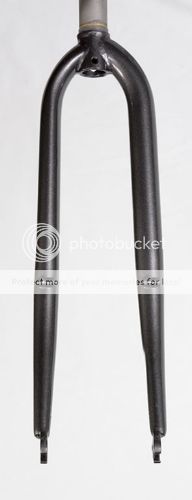
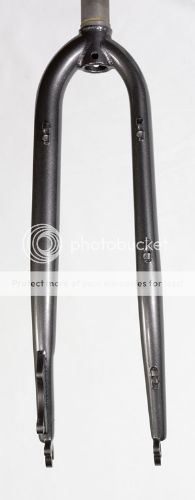
and a pic of the bike
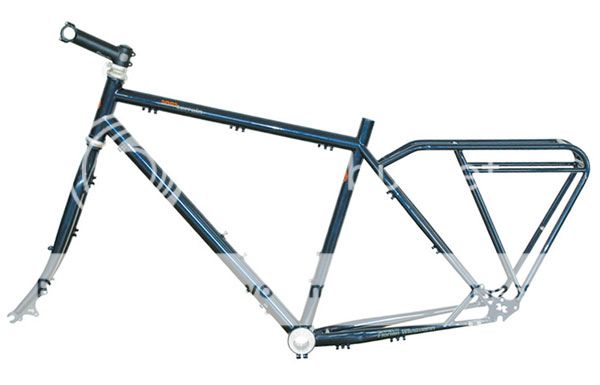
A few pics of forks from https://waltworks.blogspot.com/2007/0...-increase.html

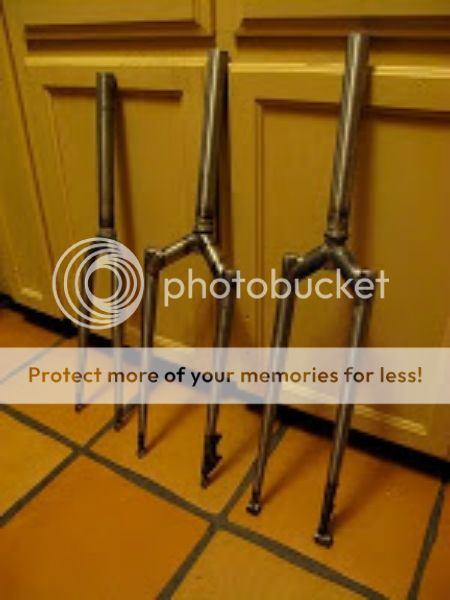
 .
.On the top you see a front view of the Silkroad fork. The blade on the left, which is actually the right blade, is thinner at the top. The blade you see on the right of the top photo, the left blade, is thicker at the top to compensate for the twisting action of the disc brake, which is attached to that fork blade. Looking at the photo on the bottom, you see the same fork, but now looking at it from behind. Now you see the left blade with the disc brake mount near the bottom, just above the dropout. On the back side of the right fork blade you see the three wire holders for the lighting system. A hub dynamo has its connectors on the right side. So the wires from the hub run up the back side of the right fork blade to the headlight mounted either at the fork crown or further up on the handlebar. The connector on the upper part of the left blade is for the disc brake line or cable housing.
The Silkroad fork is designed from the ground up as a disc brake fork. It's asymmetrical to eliminate torque steer from the disc brake. The left blade is much stiffer than the right blade. The dropouts face forward so that the action of the disc brake pulls the hub into the dropout.


and a pic of the bike

A few pics of forks from https://waltworks.blogspot.com/2007/0...-increase.html


__________________
Brian
Brian
Last edited by calstar; 03-20-13 at 10:16 AM.
#6
Senior Member
Join Date: Sep 2009
Location: EagleRiver AK
Posts: 1,306
Mentioned: 0 Post(s)
Tagged: 0 Thread(s)
Quoted: 28 Post(s)
Likes: 0
Liked 60 Times
in
33 Posts
One approach I have seen to address disks on tapered forks is to use a "willits" style disk tab that extends a good 6"+ above the upper mounting bolt, so the twisting force of the caliper is distributed along a much longer section of the fork, and the long tab itself adds some stiffness in axis needed. See these;
https://www.paragonmachineworks.com/c...ion&key=BK2009
https://ifbikesblog.blogspot.com/2009...disc-tabs.html
I would at minimum use the tandem CS, but since the Nova crown takes a ovalized 25.4 tube, you could also just start with a non-tapered 1" diameter 4130 tube of suitable wall thickness for the disk side, would be much stiffer in vicinity of the disk mount than a tapered leg.
https://www.paragonmachineworks.com/c...ion&key=BK2009
https://ifbikesblog.blogspot.com/2009...disc-tabs.html
I would at minimum use the tandem CS, but since the Nova crown takes a ovalized 25.4 tube, you could also just start with a non-tapered 1" diameter 4130 tube of suitable wall thickness for the disk side, would be much stiffer in vicinity of the disk mount than a tapered leg.
#7
Senior Member
Thread Starter
Join Date: Mar 2012
Location: santa barbara CA
Posts: 1,087
Mentioned: 1 Post(s)
Tagged: 0 Thread(s)
Quoted: 96 Post(s)
Liked 30 Times
in
21 Posts
I had to hunt for this, knew I saw it someplace, Alex Wetmore's use of an elongated Paragon Willits(i think) mounting tab. What do you think of its strength relative to keeping the blade from unraking? Looks like its about half the blade length.
thanks, Brian
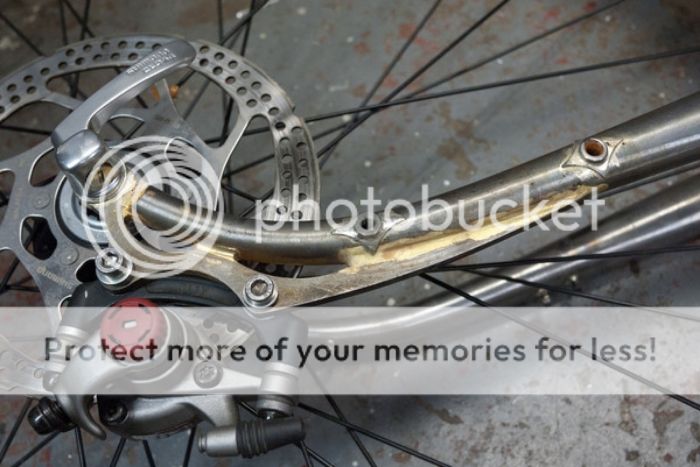

thanks, Brian


__________________
Brian
Brian
Last edited by calstar; 03-20-13 at 05:45 PM.
#8
Senior Member
It's probably okay. He CNC'd the mount to match the large offset btw. Dave Kirk also does disk forks with normal blades and he's smart! It's certainly more aesthetically appealling compared to a unicrown with fat blades (with a smaller disk mount). It would be interesting to see how the two types compares in weight and flexibility.
Last edited by tuz; 03-20-13 at 06:05 PM.
#9
Randomhead
Join Date: Aug 2008
Location: Happy Valley, Pennsylvania
Posts: 24,392
Mentioned: 0 Post(s)
Tagged: 0 Thread(s)
Quoted: 4 Post(s)
Liked 3,690 Times
in
2,513 Posts
there have been plenty of reports of blades un-raking. I guess it depends on the user as much as anything. I am not sure I understand the dislike for unicrown forks. They look better than segmented forks and many forks with crowns to me.
#10
Senior Member
Thread Starter
Join Date: Mar 2012
Location: santa barbara CA
Posts: 1,087
Mentioned: 1 Post(s)
Tagged: 0 Thread(s)
Quoted: 96 Post(s)
Liked 30 Times
in
21 Posts
As to the aesthetics of a unicrown vs segmented vs "normal" fork crown I'd say, like any personal taste, its all in the eye of the beholder. Any reason not to use a bi-plane crown with a disc fork(structurally)?
thanks, Brian
thanks, Brian
__________________
Brian
Brian
Last edited by calstar; 03-20-13 at 07:14 PM.
#11
Randomhead
Join Date: Aug 2008
Location: Happy Valley, Pennsylvania
Posts: 24,392
Mentioned: 0 Post(s)
Tagged: 0 Thread(s)
Quoted: 4 Post(s)
Liked 3,690 Times
in
2,513 Posts
you mean plate crown? I think a plate crown is a fairly strong way to make a fork
#12
Senior Member
Join Date: Nov 2010
Location: River City, OR
Posts: 672
Mentioned: 0 Post(s)
Tagged: 0 Thread(s)
Quoted: 9 Post(s)
Likes: 0
Liked 1 Time
in
1 Post
Any good reason to go away from a rim brake? As you said, "it's in the eye of the beholder," and to my eye adding a modern brake (disc) to an old school fork (twin plate crown/curved blade) just doesn't seem right. Gonna add some late DuraAce cranks too?
#13
Senior Member
Yes I guess the critical point is the blade and disk mount. A plate crown would be good way to use fatter blades.
Btw I thought that the idea behind tapered & raked forks was to give some amount of shock absorption. A properly designed disk fork might not have much compliance left and will gain some weight? (along with the disk hardware). Even if it's simply a long Willits mount. Something to weight against the good performance of (hydraulic?) disk brakes.
Btw I thought that the idea behind tapered & raked forks was to give some amount of shock absorption. A properly designed disk fork might not have much compliance left and will gain some weight? (along with the disk hardware). Even if it's simply a long Willits mount. Something to weight against the good performance of (hydraulic?) disk brakes.
#14
Senior Member
Thread Starter
Join Date: Mar 2012
Location: santa barbara CA
Posts: 1,087
Mentioned: 1 Post(s)
Tagged: 0 Thread(s)
Quoted: 96 Post(s)
Liked 30 Times
in
21 Posts
Btw I thought that the idea behind tapered & raked forks was to give some amount of shock absorption. A properly designed disk fork might not have much compliance left and will gain some weight? (along with the disk hardware). Even if it's simply a long Willits mount. Something to weight against the good performance of (hydraulic?) disk brakes.
Brian
__________________
Brian
Brian
#15
Senior Member
Join Date: Sep 2009
Location: EagleRiver AK
Posts: 1,306
Mentioned: 0 Post(s)
Tagged: 0 Thread(s)
Quoted: 28 Post(s)
Likes: 0
Liked 60 Times
in
33 Posts
For a MTB project, seems like an unraked, untapered segmented crown fork would look more at home than a road-style fork. Good thread on construction of these over at; https://forums.mtbr.com/frame-buildin...es-711257.html
An MTB tire is going to provide much more suspension compliance than a skinny, flexy road style fork ever could hope to achieve, much better to have a stout fork for offroad+disks that will not bend/break.
An MTB tire is going to provide much more suspension compliance than a skinny, flexy road style fork ever could hope to achieve, much better to have a stout fork for offroad+disks that will not bend/break.
#16
Senior Member
Thread Starter
Join Date: Mar 2012
Location: santa barbara CA
Posts: 1,087
Mentioned: 1 Post(s)
Tagged: 0 Thread(s)
Quoted: 96 Post(s)
Liked 30 Times
in
21 Posts
For a MTB project, seems like an unraked, untapered segmented crown fork would look more at home than a road-style fork. Good thread on construction of these over at; https://forums.mtbr.com/frame-buildin...es-711257.html
An MTB tire is going to provide much more suspension compliance than a skinny, flexy road style fork ever could hope to achieve, much better to have a stout fork for offroad+disks that will not bend/break.
An MTB tire is going to provide much more suspension compliance than a skinny, flexy road style fork ever could hope to achieve, much better to have a stout fork for offroad+disks that will not bend/break.
Brian
__________________
Brian
Brian
#17
Senior Member
Join Date: Apr 2010
Location: vermont
Posts: 3,081
Bikes: Many
Mentioned: 8 Post(s)
Tagged: 0 Thread(s)
Quoted: 5 Post(s)
Likes: 0
Liked 10 Times
in
10 Posts
Here ya go. You mount the caliper on a bracket that goes directly to the axle and can rotate on the axle on a bearing (bushing). Near where the caliper mounts to the bracket, there is another small bushing. This is called a lower stay rod bushing. The upper stay rod bushing bolts to the fork crown.
When the bike is moving and you apply the brake, the caliper pulls down on the stay rod causing the brake force to move upward directly toward the upper stay rod bolt where it belongs, in a nice thick chunk of metal.
Welding a gusset on a skinny tapered blade is so very bad. There is nothing about a tapered fork blade that should be near a disk brake caliper unless it is very large, thick and straight. Torch brazing on the fork blade will jeopardize the condition of the material in a critical area. ending the gusset at the drilled hole is so wrong it's not even funny.

road-brake by frankthewelder, on Flickr
When the bike is moving and you apply the brake, the caliper pulls down on the stay rod causing the brake force to move upward directly toward the upper stay rod bolt where it belongs, in a nice thick chunk of metal.
Welding a gusset on a skinny tapered blade is so very bad. There is nothing about a tapered fork blade that should be near a disk brake caliper unless it is very large, thick and straight. Torch brazing on the fork blade will jeopardize the condition of the material in a critical area. ending the gusset at the drilled hole is so wrong it's not even funny.

road-brake by frankthewelder, on Flickr
Last edited by ftwelder; 03-23-13 at 06:18 AM.
#18
Senior Member
Thread Starter
Join Date: Mar 2012
Location: santa barbara CA
Posts: 1,087
Mentioned: 1 Post(s)
Tagged: 0 Thread(s)
Quoted: 96 Post(s)
Liked 30 Times
in
21 Posts
Hi Frank, have you built or seen such a fork? I'd really like to see this design on a build. Is this related in some way to the loading of a springer fork where the force is transfered to the spring attachment on the steerer?
thanks, Brian
thanks, Brian
__________________
Brian
Brian
Last edited by calstar; 03-23-13 at 09:28 AM.
#19
Senior Member
Join Date: Apr 2010
Location: vermont
Posts: 3,081
Bikes: Many
Mentioned: 8 Post(s)
Tagged: 0 Thread(s)
Quoted: 5 Post(s)
Likes: 0
Liked 10 Times
in
10 Posts
I am not sure where the linkage was first used but It pops up from time to time. I think the earles suspension fork may have used that type of linkage to control brake dive.
Here is a very early example of Earles type suspension. Earles was patented in the early 50's but this conversion may be older than that. It may have worked better if the fork were spun around on this example. zero trail?
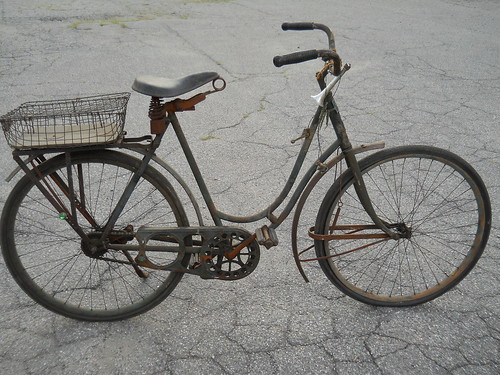
29 063 by barnstormerbikes, on Flickr
#20
Senior Member
Thread Starter
Join Date: Mar 2012
Location: santa barbara CA
Posts: 1,087
Mentioned: 1 Post(s)
Tagged: 0 Thread(s)
Quoted: 96 Post(s)
Liked 30 Times
in
21 Posts
I see the axle is a couple inches in front of the drop and what looks like a turnbuckle with small dia rods(not parallel) connected to the lever arm going up to the rear of the crown. The wheel/axle rotates up around the pivot point on the drop when it goes over a bump and the lever connected to the crown by the rods keeps the wheel from rising too much, is that correct?
another disc fork design I saw while browsing, a tapered blade disc mount by David Kirk and the same pic from above(Paragon Willits) for comparison


Brian
another disc fork design I saw while browsing, a tapered blade disc mount by David Kirk and the same pic from above(Paragon Willits) for comparison


Brian
__________________
Brian
Brian
Last edited by calstar; 03-24-13 at 10:46 AM.
#21
Randomhead
Join Date: Aug 2008
Location: Happy Valley, Pennsylvania
Posts: 24,392
Mentioned: 0 Post(s)
Tagged: 0 Thread(s)
Quoted: 4 Post(s)
Liked 3,690 Times
in
2,513 Posts
Pretty sure that the Wetmore design is part of the dropout and isn't actually a Willits. Although it certainly looks like one
#22
Senior Member
Join Date: Apr 2010
Location: vermont
Posts: 3,081
Bikes: Many
Mentioned: 8 Post(s)
Tagged: 0 Thread(s)
Quoted: 5 Post(s)
Likes: 0
Liked 10 Times
in
10 Posts
on the old Earles fork the vertical rods pull on coiled springs. There may be a wire inside the spring to limit travel.
The problem with using tapered blades and the gussets is the brake force is opposite of the road force in a spot that wasn't engineered to handle the load. When you have the brake on and hit a bump it multiplies the force pulling on that brake tab which is a strong chunk of metal held to a thin tube (already stretched from a bending process) with a low tensile material.
I raced downhill for 15 years as an expert on bikes I engineered and fabricated. I get fear looking at those forks. I don't have an engineering degree and my opinion is lodged in a rotting old brain. There is always someone who displays irrational fear, perhaps it's me.
Time will tell.
I have wondered about the potential of an unintentional fulcrum when the caliper grabs the rotor. It seems like it could only happen if something solid went through the rotor at the caliper.
The problem with using tapered blades and the gussets is the brake force is opposite of the road force in a spot that wasn't engineered to handle the load. When you have the brake on and hit a bump it multiplies the force pulling on that brake tab which is a strong chunk of metal held to a thin tube (already stretched from a bending process) with a low tensile material.
I raced downhill for 15 years as an expert on bikes I engineered and fabricated. I get fear looking at those forks. I don't have an engineering degree and my opinion is lodged in a rotting old brain. There is always someone who displays irrational fear, perhaps it's me.
Time will tell.
I have wondered about the potential of an unintentional fulcrum when the caliper grabs the rotor. It seems like it could only happen if something solid went through the rotor at the caliper.
#23
Senior Member
Join Date: Feb 2013
Posts: 66
Mentioned: 0 Post(s)
Tagged: 0 Thread(s)
Quoted: 0 Post(s)
Likes: 0
Liked 0 Times
in
0 Posts
The "unintentional fulcrum" was the root of the disc brake ejection problem - where pulling the brakes caused the wheel to be forced out of the dropouts, often with disastrous consequences. The effect was most pronounced with lightweight forks - the definitive case, James Annan's documented failure - was with lightweight disc forks on a tandem.
#24
Senior Member
Thread Starter
Join Date: Mar 2012
Location: santa barbara CA
Posts: 1,087
Mentioned: 1 Post(s)
Tagged: 0 Thread(s)
Quoted: 96 Post(s)
Liked 30 Times
in
21 Posts
FTW: ..."my opinion is lodged in a rotting old brain"
Come on Frank, this is obviously a ploy for sympathy which is quickly disregarded for those of us who lived through the 1960s
On another note I googled James Annan as menioned by BenCooper and found multiple sites with tons of info and discussion on bicycle forks and disc brakes which are linked below. If you have any questions regarding safety/forks/discs its likey covered somewhere in the link info.
https://www.ne.jp/asahi/julesandjames...quick_release/
https://yarchive.net/bike/disk_brake_qr.html
Most of the discussions/info deal with the forces generated by the disc brake forcing the wheel/axle down and out of the dropouts(yes, even with lawyer lips), and not much on the blade "unraking"(at least in my reading on the subject offered in the links). In no way am I implying fork unraking doesn't happen, only that the analysis in the links focuses on wheel/axle ejection.
here's some testing Cannondale did with analysis of the testing by others(10yrs past):
https://www.ne.jp/asahi/julesandjames...annondale.html
At this point my thinking is radiused blades and disc brakes are not a wise choice, as several of you have pointed out(more than once), and I won't be building one.
cheers, Brian
Come on Frank, this is obviously a ploy for sympathy which is quickly disregarded for those of us who lived through the 1960s

On another note I googled James Annan as menioned by BenCooper and found multiple sites with tons of info and discussion on bicycle forks and disc brakes which are linked below. If you have any questions regarding safety/forks/discs its likey covered somewhere in the link info.
https://www.ne.jp/asahi/julesandjames...quick_release/
https://yarchive.net/bike/disk_brake_qr.html
Most of the discussions/info deal with the forces generated by the disc brake forcing the wheel/axle down and out of the dropouts(yes, even with lawyer lips), and not much on the blade "unraking"(at least in my reading on the subject offered in the links). In no way am I implying fork unraking doesn't happen, only that the analysis in the links focuses on wheel/axle ejection.
here's some testing Cannondale did with analysis of the testing by others(10yrs past):
https://www.ne.jp/asahi/julesandjames...annondale.html
At this point my thinking is radiused blades and disc brakes are not a wise choice, as several of you have pointed out(more than once), and I won't be building one.
cheers, Brian
__________________
Brian
Brian
Last edited by calstar; 03-25-13 at 05:31 PM.
#25
Randomhead
Join Date: Aug 2008
Location: Happy Valley, Pennsylvania
Posts: 24,392
Mentioned: 0 Post(s)
Tagged: 0 Thread(s)
Quoted: 4 Post(s)
Liked 3,690 Times
in
2,513 Posts
I can name at least 2 fairly well known builders that have had forks "unrake." I'm sure we'll find out if Alex Wetmore's fork unrakes itself, but that probably is not going to happen.






